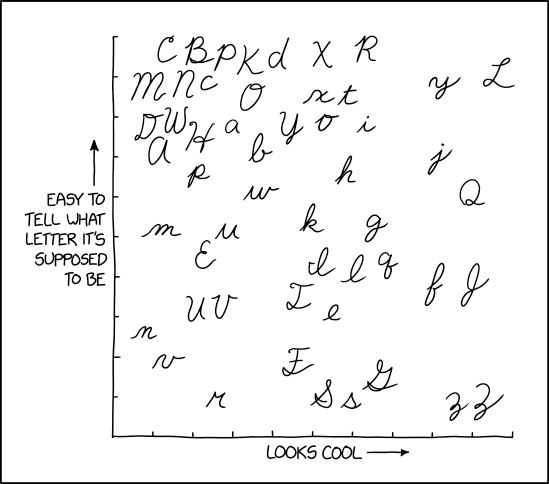510x109 is 510 billion. Earth surface area is 510 trillion.
Cursive Letters

𝓘 𝓽𝓱𝓲𝓷𝓴 𝓬𝓪𝓹𝓲𝓽𝓪𝓵 𝓛 𝓲𝓼 𝓹𝓻𝓸𝓫𝓪𝓫𝓵𝔂 𝓽𝓱𝓮 𝓶𝓸𝓼𝓽 𝓯𝓾𝓷 𝓽𝓸 𝔀𝓻𝓲𝓽𝓮, 𝓽𝓱𝓸𝓾𝓰𝓱 𝓵𝓸𝔀𝓮𝓻𝓬𝓪𝓼𝓮 𝓺 𝓲𝓼 𝓪𝓵𝓼𝓸 𝓪 𝓼𝓽𝓻𝓸𝓷𝓰 𝓬𝓸𝓷𝓽𝓮𝓷𝓭𝓮𝓻.
510x109 is 510 billion. Earth surface area is 510 trillion.
Yep log(510*10^{12})/log(2) \approx 49
Only off by a factor of 1000 ![]()
Brian
I completely misinterpreted the cartoon until just a moment ago. I thought it was joking about the distortions the Mercator projection introduces; I was completely whooshed by the joke that it was talking about the literal physical size of the map on the wall.
![]()
I did it in SI, not US customary units, but in hindsight I realize I converted km^2 to m^2 with a factor of 1000, not 1000000. Oops.
So yeah, 10 more folds = 49 total to reduce the map to ~ 1m^2.
…Huh. So it is. So why the heck does everything written about the Mercator projection always show the diagram where y = R\tan(\phi) ?
Even if you made the map of graphene–a single layer of carbon atoms–the resulting “folded” map would be 170 kilometers thick. The folding is gonna be a trick, though.
I suppose you could have a really thin map that spirals around the Earth, like what you get from an apple peeler. Then you can fold it in a zig-zag fashion and not have the problems you get when repeatedly halving it.
Dunno. Maybe confusion between different cylindrical projections? They all have the same sort of problem where things go divergent at the poles. But that \ln makes things a little less extreme.
I see that Encyclopedia Britannica has this image:

It confused me too at first glance, but they’re differentiating between a “simple cylindrical projection” and Mercator. Mercator rescales the lines of latitude to preserve shape.
That’s a fun idea. Thank you
I have a nagging memory that we had a thread back around 2005 or so about a young woman who had recently broken the record for most halving folds in a piece of paper. IIRC @Chronos was prominent in the thread. Or else it was the similarly esteemed and now sadly late @Q.E.D.
I don’t have quite enough memory tendrils to successfully search up the thread now. Does that ring a bell with anyone?
It would be interesting to compare the most folds ever achieved with the number required to make our 1 m^2 folded 1:1 scale Mercator.
Here is the original thread. There have also been several interesting discussions of paper folding since then.
Maybe one of these?
Or maybe this column by Cecil.
Surely, the simplest cylindrical projection is the one with y=R\phi, and the one with y=R\sin\phi (i.e., the Peters projection) is at least as “simple” as the one with y = R\tan\phi . Those both still have a coordinate singularity at the poles (indeed, any flat map projection will have a coordinate singularity somewhere), but they at least map the poles to lines a finite distance from the Equator.
And yeah, I’m a big fan of any middle-schooler who not only recognizes that a mathematical problem can be solved, but then does so, very thoroughly, and then also puts it to the experimental test.
Well, the formulas look easier in those cases, but I’d say the light-projection version is the simplest in an intuitive sense, and something you can actually perform in real life. It makes the singularities apparent since the cylinder has no top or bottom, so a beam of light going in those directions must necessarily miss the map. But you’re right–there are lots of cylindrical projections with no singularity.
Here is the original thread. There have also been several interesting discussions of paper folding since then.
Bingo! Thank you!
And honorable mention to @TroutMan just below.
I did get the timeframe right (2005), but flubbed the dub on @Chronos or @Q.E.D
Well, the formulas look easier in those cases, but I’d say the light-projection version is the simplest in an intuitive sense, and something you can actually perform in real life.
The tangent one projects out from a single point; the sine one projects out perpendicular to the axis. It might be easier to build a physical light projector for the tangent one, but I think that conceptually, it’s about a tie.
Yep log(51010^{12})/log(2) \approx 49log(510∗1012)/log(2)≈49log(51010^{12})/log(2) \approx 49
Only off by a factor of 1000
Another reminder that 2^10 is darn close to 1000. If you approximate 510 as 512 (2^9) and a trillion = 10^12 ~ 2^40, you get 49 folds without having to do the actual logs.
Yeah, since 2 ≈ 10.301, binary and decimal exponents remain close to 10/3 up to pretty high values; you’d have to go up to about 1090 before 2299 would be a better approximation than 2300.

𝓘 𝓽𝓱𝓲𝓷𝓴 𝓬𝓪𝓹𝓲𝓽𝓪𝓵 𝓛 𝓲𝓼 𝓹𝓻𝓸𝓫𝓪𝓫𝓵𝔂 𝓽𝓱𝓮 𝓶𝓸𝓼𝓽 𝓯𝓾𝓷 𝓽𝓸 𝔀𝓻𝓲𝓽𝓮, 𝓽𝓱𝓸𝓾𝓰𝓱 𝓵𝓸𝔀𝓮𝓻𝓬𝓪𝓼𝓮 𝓺 𝓲𝓼 𝓪𝓵𝓼𝓸 𝓪 𝓼𝓽𝓻𝓸𝓷𝓰 𝓬𝓸𝓷𝓽𝓮𝓷𝓭𝓮𝓻.
It’s a cool letter but it doesn’t put on airs; judging from the desks I’ve seen, cool S is not too cool for school
I completely misinterpreted the cartoon until just a moment ago. I thought it was joking about the distortions the Mercator projection introduces; I was completely whooshed by the joke that it was talking about the literal physical size of the map on the wall
Me too. I’m not smart enough for every xkcd.